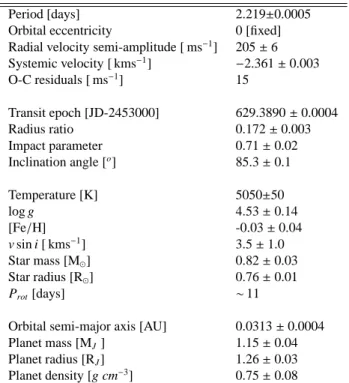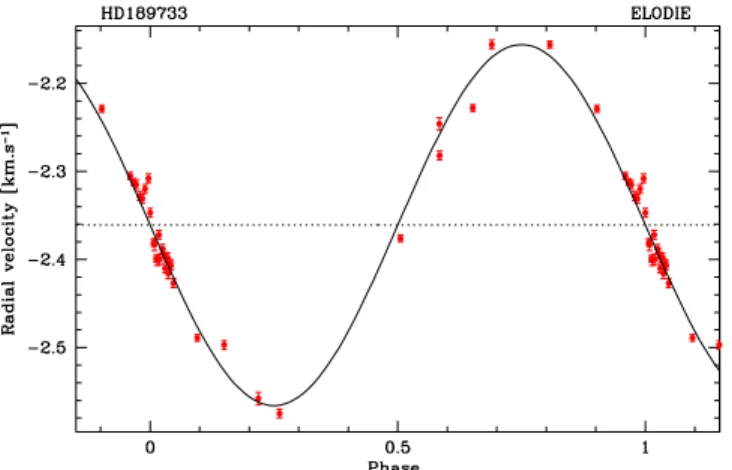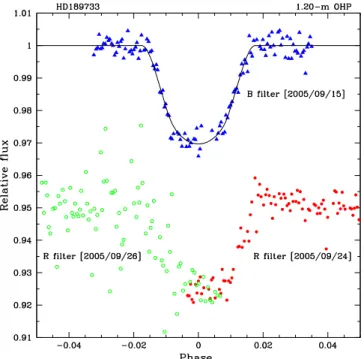HAL Id: hal-00009554
https://hal.archives-ouvertes.fr/hal-00009554
Preprint submitted on 5 Oct 2005
HAL is a multi-disciplinary open access
archive for the deposit and dissemination of
sci-entific research documents, whether they are
pub-lished or not. The documents may come from
teaching and research institutions in France or
abroad, or from public or private research centers.
L’archive ouverte pluridisciplinaire HAL, est
destinée au dépôt et à la diffusion de documents
scientifiques de niveau recherche, publiés ou non,
émanant des établissements d’enseignement et de
recherche français ou étrangers, des laboratoires
publics ou privés.
ELODIE metallicity-biased search for transiting Hot
Jupiters II. A very hot Jupiter transiting the bright K
star HD189733
Francois Bouchy, Stephane Udry, Michel Mayor, Claire Moutou, Frederic
Pont, Nicolas Iribarne, Ronaldo da Silva, Sergio Ilovaisky, Didier Queloz,
Nuno Santos, et al.
To cite this version:
Francois Bouchy, Stephane Udry, Michel Mayor, Claire Moutou, Frederic Pont, et al.. ELODIE
metallicity-biased search for transiting Hot Jupiters II. A very hot Jupiter transiting the bright K star
HD189733. 2005. �hal-00009554�
ccsd-00009554, version 1 - 5 Oct 2005
(DOI: will be inserted by hand later)
ELODIE metallicity-biased search for transiting Hot Jupiters
⋆
II. A very hot Jupiter transiting the bright K star HD 189733
F. Bouchy
1,2, S. Udry
3, M. Mayor
3, C. Moutou
1, F. Pont
3, N. Iribarne
2, R. Da Silva
3, S. Ilovaisky
2, D. Queloz
3,
N.C. Santos
3,4, D. Segransan
3, and S. Zucker
3,51 Laboratoire d’Astrophysique de Marseille, Traverse du Siphon, 13013 Marseille, France 2 Observatoire de Haute Provence, 04870 St Michel l’Observatoire, France
3 Observatoire de Gen`eve, 51 ch. des Maillettes, 1290 Sauverny, Switzerland 4 Lisbon Observatory, Tapada da Ajuda, 1349-018 Lisboa, Portugal
5 Weizmann Institute of Science, PO Box 26, Rehovot 76100, Israel
Received ; accepted
Abstract.Among the 160 known exoplanets, mainly detected in large radial-velocity surveys, only 8 have a characterization
of their actual mass and radius thanks to the two complementary methods of detection: radial velocities and photometric transit. We started in March 2004 an exoplanet-search programme biased toward high-metallicity stars which are more frequently host extra-solar planets. This survey aims to detect close-in giant planets, which are most likely to transit their host star.
For this programme, high-precision radial velocities are measured with the ELODIE fiber-fed spectrograph on the 1.93-m telescope, and high-precision photometry is obtained with the CCD Camera on the 1.20-m telescope, both at the Haute-Provence Observatory.
We report here the discovery of a new transiting hot Jupiter orbiting the star HD 189733. The planetary nature of this object is confirmed by the observation of both the spectroscopic and photometric transits. The exoplanet HD 189733 b, with an orbital period of 2.219 days, has one of the shortest orbital periods detected by radial velocities, and presents the largest photomet-ric depth in the light curve (∼ 3%) observed to date. We estimate for the planet a mass of 1.15 ± 0.04 MJ and a radius of
1.26 ± 0.03 RJ. Considering that HD 189733 has the same visual magnitude as the well known exoplanet host star HD 209458,
further ground-based and space-based follow-up observations are very promising and will permit a characterization of the atmosphere and exosphere of this giant exoplanet.
Keywords. stars: individual: HD 189733 – planetary systems – techniques: radial velocities – techniques: photometry
1. Introduction
Within the last ten years more than 150 planetary systems have been discovered, mostly by radial-velocity surveys. Although they provide a great deal of information on the system orbital parameters and on the host star properties, such surveys neither yield the acurate mass of the planet (only m sini) nor give any information about its size. The observation of planetary transits together with radial-velocity measurements yield, on the other hand, the actual mass and planetary radius (and thus mean den-sity), providing constraints for planet interior models.
Within the past two years, 6 exoplanets have been discov-ered first by the photometric observation of a transit in front of the stellar disk and then confirmed by spectroscopic follow-up: OGLE-TR-56b (Konacki et al. 2003), OGLE-TR-113b and 132b (Bouchy et al. 2004), TrES-1 (Alonso et al. 2004),
OGLE-Send offprint requests to: e-mail: Francois.Bouchy@oamp.fr
⋆ Based on observations collected with the ELODIE spectrograph
on the 1.93-m telescope and with the 1.20-m telescope (Observatoire de Haute Provence, France)
TR-111b (Pont et al. 2004) and OGLE-TR-10b (Bouchy et al. 2005; Konacki et al. 2005). Only 2 transiting exoplanets have been discovered first by radial velocities and then had their photometric transit measured: HD209458 (Mazeh et al. 2000; Charbonneau et al. 2000; Henry et al. 2000) and HD149026 (Sato et al. 2005). The host stars of the 5 OGLE planets are unfortunately faint and complementary follow-up observations are difficult and time-consuming. We present in this letter a new transiting hot Jupiter orbiting the bright (V = 7.7) and close (d = 19 pc) star HD 189733.
2. Observations
HD 189733 belongs to our “ELODIE metallicity-biased search for transiting Hot Jupiters” survey (Da Silva et al. 2005). This survey started in March 2004 with the ELODIE spectrograph (Baranne et al. 1996) on the 1.93-m telescope at the Haute-Provence Observatory (France). The main idea of the pro-gramme is to bias the target sample for high-metallicity stars which are more likely to host planets (Gonzales 1998; Santos
2 Bouchy et al.: The transiting hot Jupiter HD 189733 b et al. 2001, 2005; Fischer & Valenti 2005). It already allowed
the discovery of 2 hot Jupiters orbiting the stars HD 118203 and HD 149143 (the latter recently announced by Fischer et al. in prep).
The observational strategy of the survey is designed to pri-marily target hot Jupiters which are ideal candidates for follow-up photometric-transit searches. In practice, the first spectro-scopic measurement is made to estimate the metallicity by measuring the surface of the cross-correlation function of the ELODIE spectrum (Santos et al. 2002). Then, the star is se-lected for further observations if the derived metallicity [Fe/H] is greater than 0.1 dex. The metallicity estimate requires a spec-trum with S/N≥40. For HD 189733, this S/N ratio was only reached after two independent exposures which, moreover, re-vealed a large velocity variation. The object was therefore fol-lowed despite the fact that the measured metallicity was not larger than 0.1. Typical exposure times were between 15 and 25 minutes, corresponding to photon-noise uncertainties of ∼ 5-7 ms−1.
A first set of 8 radial velocities of HD 189733, showing a large-amplitude variation, allowed us to easily constrain a cir-cular orbital solution with a very short period (2.2 days) for the companion. With such a short period, the probability that the companion crosses the stellar disk is quite high (∼1/8). We thus decided to attempt to measure the transit both in spectroscopy (Rossiter-McLaughlin effect) using the ELODIE spectrograph, and in photometry using the 1.20-m telescope on the same site. The f/6 Newton focus of the 1.20-m telescope is equipped with a CCD camera system (1024×1024 SITe back-illuminated CCD) giving a field of view of 11.8 arcmin size and a projected pixel size of 0.69 arcec. A filter wheel holds the filters U’, B, V, Rcand Ic. The observation sampling was limited by the read-out time of the CCD controller (90 s). Basic data processing and DAOPHOT stellar photometry (Stetson 1987) were applied to the images. Aperture photometry of both brightest stars in the field was performed, with an aperture of 14 pixels. Correction of the sky background and cosmic removal were also applied. The final light curves were then obtained using a single refer-ence star, and applying an extinction correction fitted on the data as a linear combination of the airmass.
3. Stellar characteristics of HD189733
HD 189733 (HIP 98505, GJ 4130) is a dwarf star in the northern hemisphere, listed in the Hipparcos catalog (ESA 1997) with a visual magnitude V = 7.67, a colour index B −
V = 0.932, and an astrometric parallax π = 51.94 ± 0.87 mas.
This puts the star at a close distance of 19.3 pc from the Sun and allows us to derive a corresponding absolute magnitude of MV= 6.25. Although the star is cataloged as G5, our analysis indicates a K1-K2 star. Following Santos et al. (2004), an LTE high-resolution spectroscopic analy-sis of a high S/N spectrum obtained with the CORALIE spectrograph gives Teff= 5050 ± 50 K, log g = 4.53 ± 0.14, and
[Fe/H] = −0.03 ± 0.04.
The V −K colour implies a temperature of 4996 ± 40 K with the calibration of Kervella et al. (2004), and the Str¨omgren pho-tometry gives 4950 ± 150 K, both estimates coherent with the
Table 1. Parameters for the star HD 189733, for the Keplerian
solution and inferred for the planetary companion. Period [days] 2.219±0.0005 Orbital eccentricity 0 [fixed] Radial velocity semi-amplitude [ ms−1] 205 ± 6
Systemic velocity [ kms−1] −2.361 ± 0.003 O-C residuals [ ms−1] 15 Transit epoch [JD-2453000] 629.3890 ± 0.0004 Radius ratio 0.172 ± 0.003 Impact parameter 0.71 ± 0.02 Inclination angle [o] 85.3 ± 0.1 Temperature [K] 5050±50 log g 4.53 ± 0.14 [Fe/H] -0.03 ± 0.04 v sin i [ kms−1] 3.5 ± 1.0 Star mass [M⊙] 0.82 ± 0.03 Star radius [R⊙] 0.76 ± 0.01 Prot[days] ∼11
Orbital semi-major axis [AU] 0.0313 ± 0.0004 Planet mass [MJ] 1.15 ± 0.04
Planet radius [RJ] 1.26 ± 0.03
Planet density [g cm−3] 0.75 ± 0.08
spectroscopic temperature. Confronting the spectroscopic pa-rameters obtained for HD 189733 with the Girardi et al. (2002) stellar evolution models gives a radius of 0.761 ± 0.014 R⊙,
and a mass of 0.81 ± 0.03 M⊙ using the V magnitude, or
0.82 ± 0.025 M⊙ using the K magnitude. From the Baraffe et
al. (1998) models, we find R = 0.75 ± 0.01 R⊙ and M =
0.80-0.85 M⊙. Kervella et al. (2004) have calibrated a relation
be-tween the V − K colour and radii measured from interferome-try that shows very little dispersion for low-mass stars (∼ 1 %). This calibration gives a radius of 0.77 R⊙ for HD 189733.
Empirical and theoretical estimates of the host star’s radius are thus in excellent agreement, with a small error interval, thanks to the star’s position in a thin and slowly-evolving part of the lower main sequence and to the precision of the Hipparcos par-allax. In the subsequent analysis we combine the above esti-mates into R = 0.76 ± 0.01 R⊙and M = 0.82 ± 0.03 R⊙.
A stellar rotation v sin i = 3.5 ± 1.0 kms−1is estimated from the calibration of the cross-correlation functions. Assuming that the stellar spin axis is perpendicular to the line of sight, we can derive the stellar rotational period of ∼11 days. The chromospheric activity index S based on the relative flux level on CaII H and K lines was measured by Wright et al. (2004). The value of S = 0.525 indicates a relatively active star.
Table 1 lists the observed and derived parameters of the star HD 189733.
4. Keplerian solution and spectroscopic transit
Radial velocity (RV) measurements of HD 189733 were con-ducted in August and September 2005 (from JD=2 453 611 to 2 453 638). Figure 1 shows the RV measurements together with the derived Keplerian solution. The short sequence of RV
Fig. 1. Radial-velocity measurements of HD 189733
super-imposed on the best Keplerian solution. The higher density of points corresponds to spectroscopic-transit measurements. They are not used to derive the Keplerian solution. Error bars represent the photon-noise uncertainties.
measurements made during the night 2 453 629 is displayed on Fig. 2 and clearly shows the RV anomaly due to the Rossiter-McLaughlin effect (spectroscopic transit). A deviation from the Keplerian solution of about ± 40 ms−1occurs because the
tran-siting planet occults first the approaching limb and then the receding limb of the rotating star. The observation of this effect provides an unambiguous confirmation of the transiting planet. Thanks to the on-line data reduction of ELODIE spectra, the RV anomaly was observed in real time during the night and revealed the transit of a planetary companion before the photo-metric analysis. HD 189733 is the third star known to present a Rossiter-McLaughlin effect due to a planetary companion and actually the first to be identified as a transiting planet
spectroscopically. Like HD 209458 (Queloz et al. 2000a) and
HD 149026 (Sato et al. 2005), HD 189733 presents a positive RV anomaly during the ingress phase of the transit and a nega-tive RV anomaly in the egress phase, indicating that the stellar rotation is in the same direction as the planet motion. The sym-metrical deviation seems to occur at mid-transit, indicating that the orbital plane is quite coplanar with the stellar equatorial plane. The amplitude of the anomaly is comparable to the one measured on HD209458 by Queloz et al. (2000a), in agreement with the fact that the star’s v sin i and the radius ratio between the planet and its host star are very close for these two systems. The Keplerian solution is derived without the RV points ob-tained during the spectroscopic transit and using the constraint of transit epochs given by the observed photometric transits. The best fit to the data yields a short-period orbit (P = 2.219 d) with an eccentricity compatible with zero. The phase-folded radial-velocity curve is displayed in Fig. 3. The orbital ele-ments are listed in Table 1, jointly with the inferred stellar and planetary parameters. The somewhat large residuals around the solution (15 ms−1) are probably explained by the
activity-induced jitter of the star. We checked (on the cross-correlation functions) that the shape of the spectral lines was not varying in phase with the radial-velocity change, what would be expected in case of spot-induced RV variations.
Fig. 2. Radial velocity sequence made on September 15th 2005
exhibiting the Rossiter-McLaughlin effect. The vertical dashed lines correspond to the first contact and last contact of the tran-sit deduced from the photometric light curve.
Fig. 3. Phase-folded radial velocity measurements of HD 189733 superimposed on the best Keplerian solution. Error bars represent the photon-noise uncertainties.
5. Photometric transit and characterisation of HD 189733 b
From the ephemeris predicted by the radial velocities, 3 transit events (nights 2 453 629, 2 453 638 and 2 453 640) have been followed in photometry with the 1.20-m telescope at OHP. The first night, a complete photometric transit was observed in the B band (Fig. 4). For the next 2 attempts, performed in the R band, only partial coverage of the transit was possible. We ob-served the transit egress on the first night and the ingress on the second. Because of non-optimum atmospheric conditions, the partial transit measurements are of poorer quality than the B-band observations, they are thus not used for our determination of the planetary parameters. They are however of prime impor-tance to confirm the transit detection and precisely specify the orbital period.
The dispersion of the light curve in the B band (Fig. 4) is about 2 mmag at the beginning of the sequence and 3 mmag at the end. The photon noise is 1.1 mmag, and the total dis-persion is primarily due to the photon-noise on the compar-ison star and to the increasing airmass. A transit light curve
4 Bouchy et al.: The transiting hot Jupiter HD 189733 b
Fig. 4. Photometric transits of HD 189733 observed with the
1.20-m OHP telescope. Triangles correspond to the observation on B band made on September 15th 2005. Full circles and open circles correspond to observation on R band made respectively on September 24th and 26th 2005. The solid curve represents the best-fit model for the complet B-band transit.
was fitted to the data using the mass and radius found for the host star in Sect. 3, the orbital parameters of Sect. 4 and limb darkening coefficients in the B filter from Claret (2000) for Teff= 5000 K, log g = 4.5 and [M/H] = 0. The free
param-eters are the transit central epoch, the radius ratio between the star and planet, and the inclination angle of the orbit. We find Ttr= 2 453 629.3890 ± 0.0004, Rpl/R = 0.172 ± 0.003 and
i = 85.3 ± 0.1. The formal uncertainties are very small. The
dominant source of error is likely to be the systematics in the photometry. To estimate their effect, we repeated the reduction of the photometry using different procedures and different com-parison stars. This resulted in a change of 4 % for the radius ratio and 0.3ofor the inclination angle. The main parameters of the planet are therefore determined with remarkable accuracy, even from the ”discovery” data, thanks to the very good deter-mination of the primary star parameters. Orbital and physical parameters of HD 189733 b are listed in Table 1.
Hipparcos (ESA 1997) observed HD189733 and obtained 176 reliable photometric measurements. Following Soderhjelm (1999), Robichon & Arenou (2000) and Castellano et al. (2000), we attempted to search for planetary transits in the Hipparcos data of HD189733. We looked for a transit signal using the same shape and depth of the transit observed with the 1.20-m. Our best solution gives a χ2 of 249 for 171
de-grees of freedom. This quite large value is explained by the 0.03 mag variability of the star which was already mentioned in the Hipparcos catalog. Our best-fit period for the Hipparcos data is P = 2.218575 ± 0.000003 days. This result was also found
Fig. 5. Mass-radius diagram for the 9 transiting exoplanets.
Jupiter and Saturn are indicated for comparison, as well as the loci of isodensities at 0.3, 0.7 and 1.3 g cm−3. Data
are from Pont et al. 2004 (OGLE-TR-111b), Konacki et al. 2005 10b), Moutou et al. 2004 (OGLE-TR-132b), Torres et al. 2004 (OGLE-TR-56b), Bouchy et al. 2004 (OGLE-TR-113b), Laughlin et al. 2005 (HD209458b and TrES-1), Sato et al. 2005 (HD149026b).
and is described in details in H´ebrard & Lecavelier des Etangs (2005).
6. Summary and concluding remarks
We have presented the characteristics of the new transiting hot Jupiter in orbit around the star HD 189733, detected by the new planet-search programme conducted with the ELODIE spectro-graph. The period derived from the RV measurements is very short (P = 2.219 d) and the orbit is circular. The photometric transit measurements allow the determination of the planetary mass (1.15 ± 0.04 MJ), radius (1.26 ± 0.03 RJ) and mean den-sity (0.75 ± 0.08 g cm−3).
Although our programme is biased towards metal-rich stars, the new candidate orbits a solar-metallicity star. Its short period tends then to weaken the proposed relation between sep-aration and metallicity for hot Jupiters (Queloz et al. 2000b; Sozzetti 2004).
Figure 5 presents the mass-radius diagram of the 9 known transiting exoplanets. In term of mass and radius, HD 189733 b is quite similar to the very hot Jupiters OGLE-TR-56 b, 113 b and 132 b.
Figure 6 displays the period-mass diagram of the 9 known transiting exoplanets. HD 189733 b appears to be intermediate between the class of very hot Jupiters and hot Jupiters and provides in some way the missing link between planets from transit and radial-velocity surveys in terms of mass and period. HD 189733 b confirms the correlation between the periods (or orbital distances) and masses of transiting exoplanets pointed out by Mazeh et al. (2005). At such a close distance from the star, it is likely that HD 189733 b undergoes some evaporation (Lecavelier et al. 2004; Baraffe et al. 2004).
With the same visual magnitude as HD 209458 and even brighter in infrared, HD 189733 belongs to the very short list of bright stars with detected planetary transits. Only
Fig. 6. Mass-period diagram for the 9 transiting exoplanets.
HD 209458 b, TrES-1, HD 149029 b and HD 189733 b have parent stars brighter than V = 12. They therefore provide pri-mary targets for additional ground-based and space-based mea-surements requiring very high signal-to-noise ratio observa-tions.
Acknowledgements. We are grateful to all the night assistants and telescope staff of Observatoire de Haute Provence for their efforts and their efficiency. We wish to thank the Programme National de Planetologie (PNP), the Swiss National Science Foundation (FNRS) and the Geneva University for their continuous support to our planet-search programs. NCS would like to thank the support from Fundac¸˜ao para a Ciˆencia e a Tecnologia (Portugal) the form of a scholarship (reference SFRH/BPD/8116/2002) and a grant (reference POCI/CTE-AST/56453/2004).
References
Alonso, R., Brown, T.M., Torres, G., et al., 2004, ApJ, 613, L153 Baraffe, I., Chabrier, G., Allard, F., et al., 1998, A&A, 337, 403 Baraffe, I., Selsis, F., Chabrier, G., et al., 2004, A&A, 419, L13 Baranne, A., Queloz, D., Mayor, M., et al., 1996, A&AS, 119, 1 Bouchy, F., Pont, F., Santos, N.C., et al., 2004, A&A, 421, L13 Bouchy, F., Pont, F., Melo, C., et al., 2005, A&A, 431, 1105 Castellano, T., Jenkins, J., Trilling, D.E., et al., 2000, ApJ, 532, L51 Charbonneau, D., Brown, T., Latham, D., et al. , 2000, ApJ, 529, L45 Claret, A., 2000, A&A, 363, 1081
Da Silva, R., Udry, S., Bouchy, F., et al., 2005, A&A, in press ESA, 1997, The HIPPARCOS and TYCHO catalogue, ESA-SP, 1200 Fischer, D.A., & Valenti, J., 2005, ApJ, 662, 1102
Girardi, M., Manzato, P., Mezzetti, M., et al., 2002, ApJ, 569, 720 Gonzalez, G., 1998, A&A, 334, 221
H´ebrard, G., & Lecavelier des Etangs, A., 2005, A&A, submitted Henry, G., Marcy, G., Butler, R. & Vogt, S., 2000, ApJ, 529, L41 Kervella, P., Thevenin, F., Di Folco, E., et al. , 2004, A&A, 426, 297 Konacki, M., Torres, G., Jha, S., et al., 2003, Nature, 421, 507; Konacki, M., Torres, G., Sasselov, D., et al., 2005, ApJ, 624, 372 Laughlin, G., Wolf, A., Vanmunster, T., et al., 2005, ApJ, 621, 1072 Lecavelier des Etangs, A., Vidal-Madjar, A., McConnell, J.C.,
Hebrard, G., 2004, A&A, 418, L1
Mazeh, T., Naef, D., Torres, G., et al., 2000, ApJ, 532, L55 Mazeh, T., Zucker, S., Pont, F., 2005, MNRAS, 356, 955 Moutou, C., Pont, F., Bouchy, F., et al., 2004, A&A, 424, L31 Pont, F., Bouchy, F., Queloz, D., et al., 2004, A&A, 426, L15 Queloz, D., Eggenberger, A., Mayor, M., et al., 2000a, A&A, 359, L13
Queloz, D., Mayor, M., Weber, L., et al., 2000b, A&A, 354, 99 Robichon, N., Arenou, F., 2000, A&A, 355, 295
Sato, B., Fischer, D.A., Henry, G., et al., 2005, ApJ, in press Santos, N.C., Israelian, G., & Mayor, M., 2001, A&A, 373, 1019 Santos, N.C., Mayor, M., Naef, D., et al., 2002, A&A, 392, 215 Santos, N.C., Israelian, G., Mayor, M., 2004, A&A, 415, 1153 Santos, N.C., Israelian, G., Mayor, M., et al. 2005, A&A, 437, 1127 Soderhjelm, S., 1999, Information Bulletin on Variable Stars, 4816, 1 Sozzetti, A., 2004, MNRAS, 354, 1194
Stetson, P.B., 1987, PASP, 99, 191
Torres, G., Konacki, M., Sasselov, D., 2004, ApJ, 609, 1071 Wright, J.T., Marcy, G.W., Butler, R.P., et al., 2004, ApJS, 152, 261



